Chargeback and showback are two very different ways to manage costs within an organization. Both of these methods have been used for decades to help organizations keep track of the costs associated with their operations. In recent years, they have become increasingly popular due to their ability to give organizations greater oversight and control over their spending. In this blog, we will explore the differences between chargeback and showback and compare their respective benefits and drawbacks to help you decide which approach is best for your organization.
What is IT Chargeback?
IT Chargeback is a method of cost allocation used by IT departments to charge individual business units or departments for the resources they consume. The chargeback process involves assigning a cost to each unit of IT resources used by the business units and then charging them for the cost of those resources based on their usage. IT Chargeback is typically used in larger organizations that want to ensure that each department is accountable for the costs associated with the IT resources they consume.
Chargeback is often used in various industries, including banking, healthcare, manufacturing, and retail. Organizations typically assign a cost to each department for the resources they use, such as servers or software licenses, and then track their usage to determine the cost of each department’s activities. By assigning each department a specific cost, organizations can ensure that each department pays its fair share of the costs associated with its activities.
What Are The Advantages Of Chargeback?

- Promotes cost-efficiency: By charging customers for IT services, organizations can ensure they are only using resources they need and are paying for what they use.
- Increased transparency: Chargebacks allow organizations to have a better understanding of their IT usage and costs. This helps ensure that IT departments are able to accurately assess the value of their services and make informed decisions about which services to continue or discontinue.
- Encourages strategic use of resources: Chargebacks incentivize users to use resources strategically and responsibly by making them accountable for their IT usage.
- Improves IT service delivery: By providing users with a better understanding of the cost of IT services, chargebacks can help IT departments deliver services more efficiently and effectively.
- Recovers costs: By imposing a chargeback system, IT departments are able to recover the cost of services used, thus providing a more sustainable funding model for the organization.
- Ensures fairness: By charging users for the services they use, chargebacks can ensure that all users are paying their fair share. This encourages users to use resources responsibly and moderately.
What Are The Disadvantages Of Chargeback?
- Creates tension and conflict between departments, potentially leading to exacerbated issues between IT and operations
- Requires businesses to perform financial true-ups against budgets on a regular and ongoing basis
- Increased the chance of accounting errors due to the nature of the method
- Requires businesses to integrate chargeback processes into existing financial systems
- Presents a lower risk of adoption across the organization and a higher risk of failure
- Can be difficult to standardize chargeback processes across departments
- Can be difficult to identify the true cost of IT services and accurately track the cost of IT services over time
- Can be time-consuming for IT departments to administer chargeback processes
What is IT Showback?
Showback is a method of cost allocation that allows organizations to track and report the costs associated with their activities but does not require them to charge each department for their usage. This method is often used in organizations that do not want to assign a cost to each department or division but still need to monitor their spending and usage.
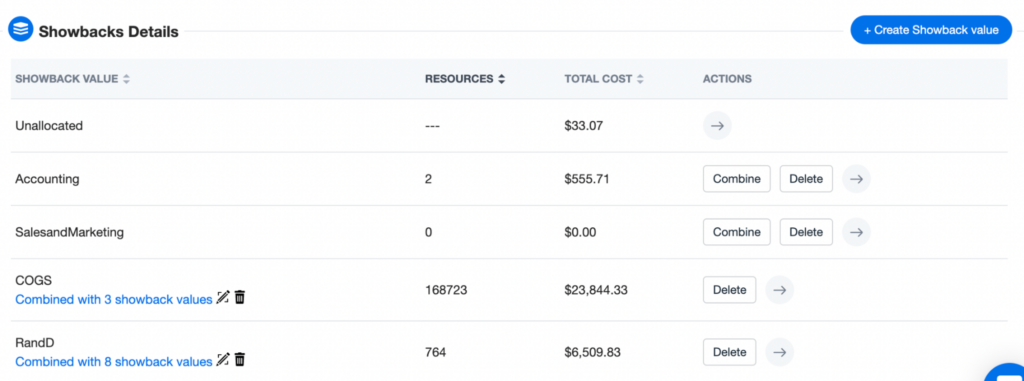
nOps dashboard show cost allocation around COGS, RnD, and accounting.
Showback reports show how much IT resources a business unit has consumed, the costs, and how they compare to their allocated budget. Showback helps organizations understand the impact of IT resource usage on their overall costs and can help identify opportunities to optimize resource usage. IT Showback is typically used to provide transparency into the IT costs and usage of the business units, but it does not involve charging them for the IT resources they consume.
There are primarily three different methods of allocating and presenting costs in showback:
- Amortized Cost:
Amortized cost involves spreading the expense of a particular resource or service over a defined period. Instead of charging the full cost upfront, it is divided into equal or proportional portions across multiple time periods. This approach is often used for costs associated with long-term assets or investments. By amortizing costs, it becomes possible to allocate the expense more evenly and accurately over time, aligning with the benefits or usage of the resource. It can help in providing a more predictable and manageable cost structure.
- Blended cost:
Blended cost refers to a combined or averaged rate used to represent the overall cost of a service or resource. It involves aggregating multiple cost components into a single value. This approach simplifies the cost allocation process by presenting a consolidated cost that encompasses various factors. The individual cost components may include things like infrastructure costs, labor costs, software licenses, maintenance fees, and other associated expenses. Blended cost provides a straightforward and easily understandable cost value, which makes it convenient for comparison and decision-making.
- Unblended cost:
Unblended cost represents the detailed, itemized breakdown of all cost components associated with a specific service or resource. Instead of combining different cost factors, unblended cost provides transparency by presenting each cost component separately. It offers a granular view of the underlying expenses, allowing stakeholders to understand precisely how costs are derived. This breakdown can include individual resource costs, usage fees, data transfer charges, storage costs, and any other relevant cost elements. Unblended cost provides a higher level of detail and accuracy, enabling more in-depth analysis, optimization, and cost attribution.

At the core of Showbacks lies Druid, a high-performance, real-time analytics database that excels in processing vast amounts of data with lightning speed. With the ability to handle billions of rows, even with high cardinality, Druid enables us to deliver sub-second OLAP queries on streaming and batch data, ensuring seamless scalability.
What Are The Advantages Of Showback?
The primary advantage of showback is that it is much simpler and less expensive than chargeback. But, here’s a detailed view:
- Encourages users to make resource-intensive changes that positively impact cost
- Correlates the cost of IT with business capabilities and goals
- Allows businesses to compare cost of vendor solutions with actual departmental usage needs
- Easy to implement
- Existing accounting systems and practices don’t need to be amended to implement showbacks
- Requires no additional accounting processes, like true-ups
- Decreases the chance for error, keeping mistakes relatively low
- Provides transparency between departments and IT
- Helps IT and business departments understand the cost of systems
- Gives a clear view of the overall IT costs for better budgeting and decision making
- Enables accurate and timely billing of IT services
- Shows the cost of IT services over time to identify cost-reduction strategies
- Allows IT organizations to anticipate demand better
- Provides detailed visibility into resource costs and the ability to distribute billing across multiple values, granting users greater control over cost allocation. Users can effortlessly explore cost data and extract insights within seconds by combining wildcard queries.
Another key aspect that truly distinguishes Showbacks lies in their real-time feedback mechanism. Showbacks offer real-time feedback, allowing users to witness data transformations instantly. Each defined rule creates a new dimension or slice, leveraging efficient caching and executing multiple queries in seconds. This flexibility accommodates complex rules and provides aggregated responses swiftly.
What Are The Disadvantages Of Showback?
- Showbacks do not incentivize departments to change their resource consumption habits, only showing them their usage.
- IT departments cannot recover costs under this model.
- Without proper communication and education, departments will not understand or be motivated to adjust their usage.
- Showbacks can be difficult to manage and monitor on a regular basis.
- The lack of granular data makes it difficult to accurately assign costs to individual departments.
- Showbacks are typically based on averages, making it difficult to identify and allocate costs.
Chargeback and showback are two very different methods of cost allocation that can be used by organizations to manage their costs. Each method has its own advantages and disadvantages, and it is important to consider these when deciding which approach is best for your organization.
Chargeback provides organizations with greater oversight and control over their spending but can be difficult to set up and maintain. Showback is simpler and less expensive than chargeback but does not provide the same level of oversight and control over spending. Ultimately, deciding which approach to use will depend on your organization’s specific needs and objectives. We hope that this blog has helped you to understand the differences between chargeback and showback and to decide which method is best for your organization.
Showbacks Vs. Chargebacks: Primary differences
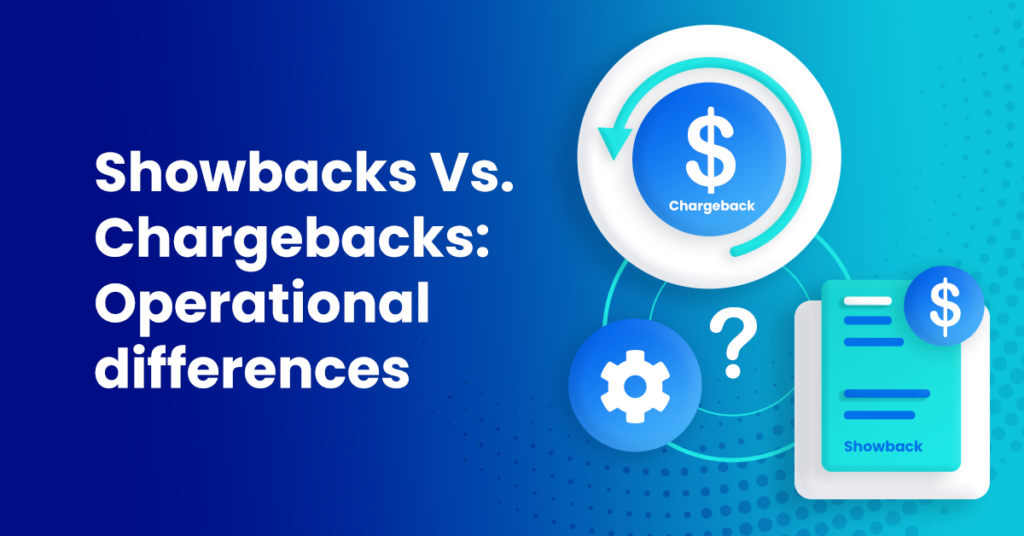
Chargebacks and showbacks have many similarities but also a few important differences. Both are used to account for the costs associated with IT services and resources. But, here are the primary differences you need to consider:
Definition
- Chargeback: A billing mechanism used by service providers to charge customers for the actual usage of resources.
- Showback: A reporting mechanism used by service providers to show customers the usage and cost of resources.
Purpose
- Chargeback: To transfer the cost of services consumed by an individual or department to that department or individual.
- Showback: To inform users about the usage and cost of resources to promote transparency and accountability.
Audience
- Chargeback: The audience for chargeback is typically finance or accounting personnel who need to allocate and recover costs.
- Showback: The audience for showback is typically IT or departmental managers who need to understand how their teams are using resources.
Timing
- Chargeback: Chargeback occurs after services have been consumed and typically involves reconciling actual usage against pre-defined cost rates.
- Showback: Showback occurs in real-time or near real-time and provides users with visibility into how their actions are impacting costs.
Granularity
- Chargeback: Chargeback typically involves detailed usage data at a granular level, such as usage by individual user, department, or application.
- Showback:Showback may involve less granular data, such as the total cost of a service or resource. However, there are different ways to distribute costs – rules and percentage distribution rules. Percentage allocation rules empower users to distribute portions of their billing across multiple Showback Values, presenting a new level of flexibility and granularity.
Cost Attribution
- Chargeback: Chargeback involves assigning costs to specific users or departments based on actual usage, typically using a pre-defined cost allocation model.
- Showback: Showback does not involve assigning costs to specific users or departments but rather providing them with information about the overall cost of resources.
Flexibility
- Chargebacks: They are a more formal approach to recovering costs. They are typically used in an enterprise setting to ensure that IT resources are allocated to the right departments and that they are used in the most efficient manner. Departments are charged for the services they use based on predetermined rates, and the funds collected are then used to cover IT costs.
- Showbacks, on the other hand, are less formal and more flexible. They are typically used in smaller organizations or departments to help IT understand the cost of providing services and resources, and to help departments plan for future IT resource needs.
Showbacks Vs. Chargebacks: Which One To Choose?
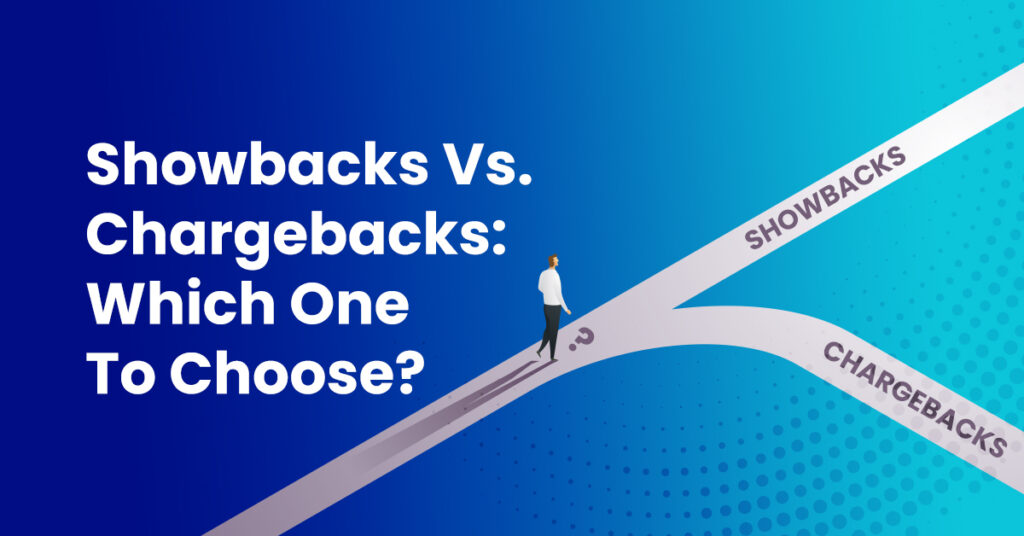
Ultimately, both approaches have their advantages, and more firms are taking advantage of the cost-saving benefits of these strategies. But, based on given pros and cons, IT showbacks are often the most suitable starting point for many businesses. This is especially true for companies that lack experience in creating IT bills, want a simple setup, are looking to avoid major process changes or connecting accounting software, or wish to avoid the potential for mistakes.
Many organizations that want to use chargebacks in the future may find it more beneficial to initially begin with showbacks. The lower complexity allows them to start quicker and refine the process over time, leading to a smoother chargeback introduction. Thus, IT Showback should be a clear choice!
How nOps can help with IT Showback?
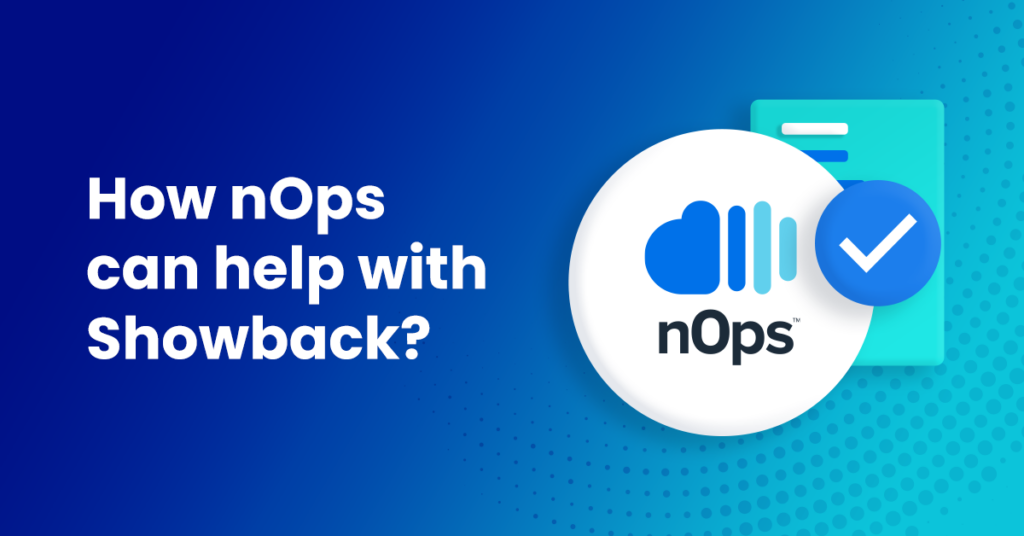
At nOps, we help you deliver FinOps in many ways. First, we provide a wide range of cost optimization capabilities to help you keep cloud spending to a minimum. We also have a “Chargebacks Center” page that lets you manage and have visibility of all of the budgets across your teams.
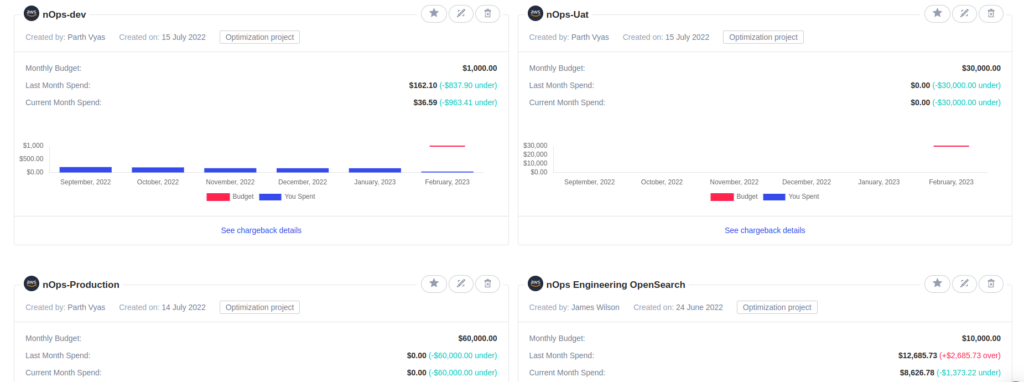
You can also see details about any specific Chargeback budget such as a chart of previous months’ spend and a spend history list.
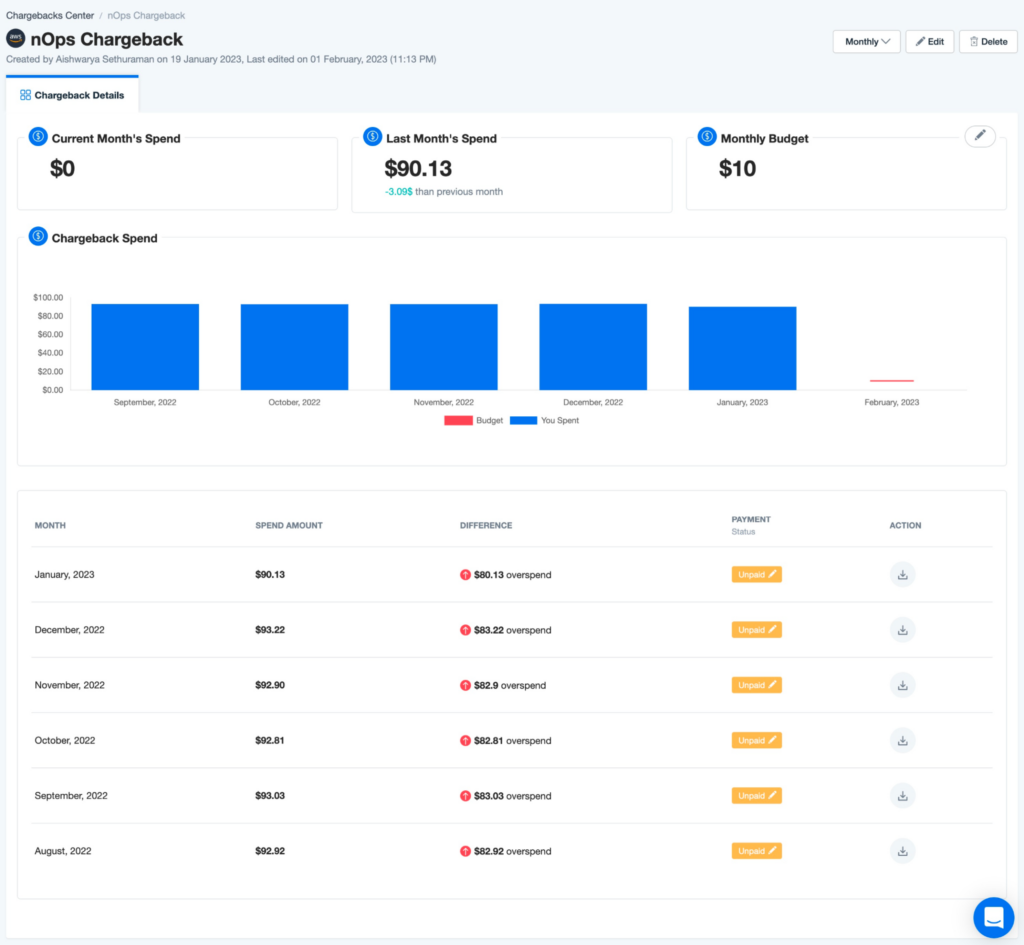
Our “Showbacks Cost Allocations” page lets you allocate the cost by adding tag policies or by adding accounts, certain usage types, or operation types.

And if you need to allocate any line items on your AWS bill across multiple teams, we have the ability to allocate them based on fixed percentages or weight them based on a percentage of spend, which accounts for variable usage among teams or services.
Here is an example of us distributing our AWS support cost by percent of spend.
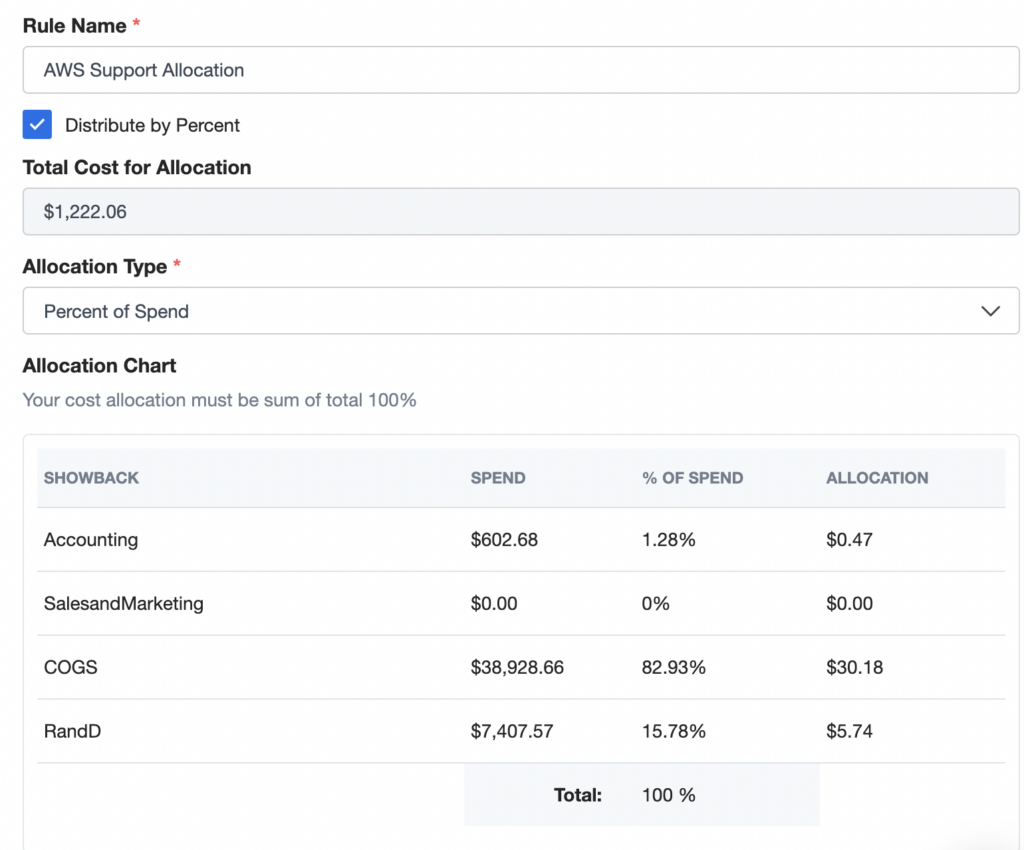
Showbacks are initiated by ingesting your Cost and Usage Report (CUR) with resource tags and metadata. The charges associated with resources, grouped by day (with hourly granularity in the pipeline), are seamlessly integrated into our OLAP database. The resulting data frame is then processed, ingested, and segmented, with each segment representing a day’s worth of data. These segments are stored in our highly performant Historical nodes, ensuring swift and efficient access to historical cost data.

By leveraging Druid and its seamless integration with our resource tagging infrastructure, Showbacks facilitate comprehensive cost analysis, empowering organizations to make data-driven decisions and optimize resource utilization precisely.
Your team focuses on innovation, while nOps runs optimization on auto-pilot to help you track, analyze, and optimize accordingly!
Let us help you save! Sign up for nOps or Book a demo call today.



